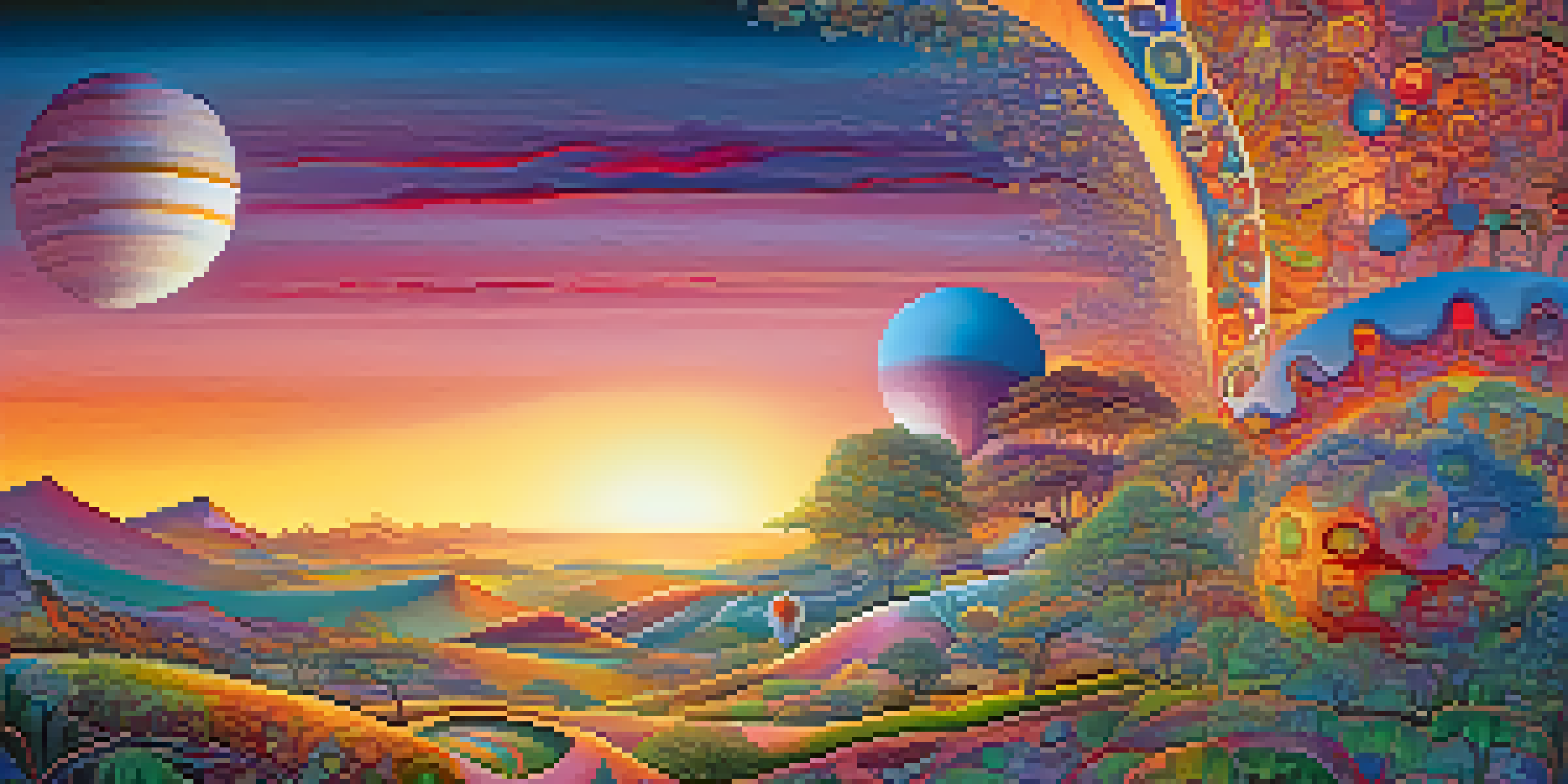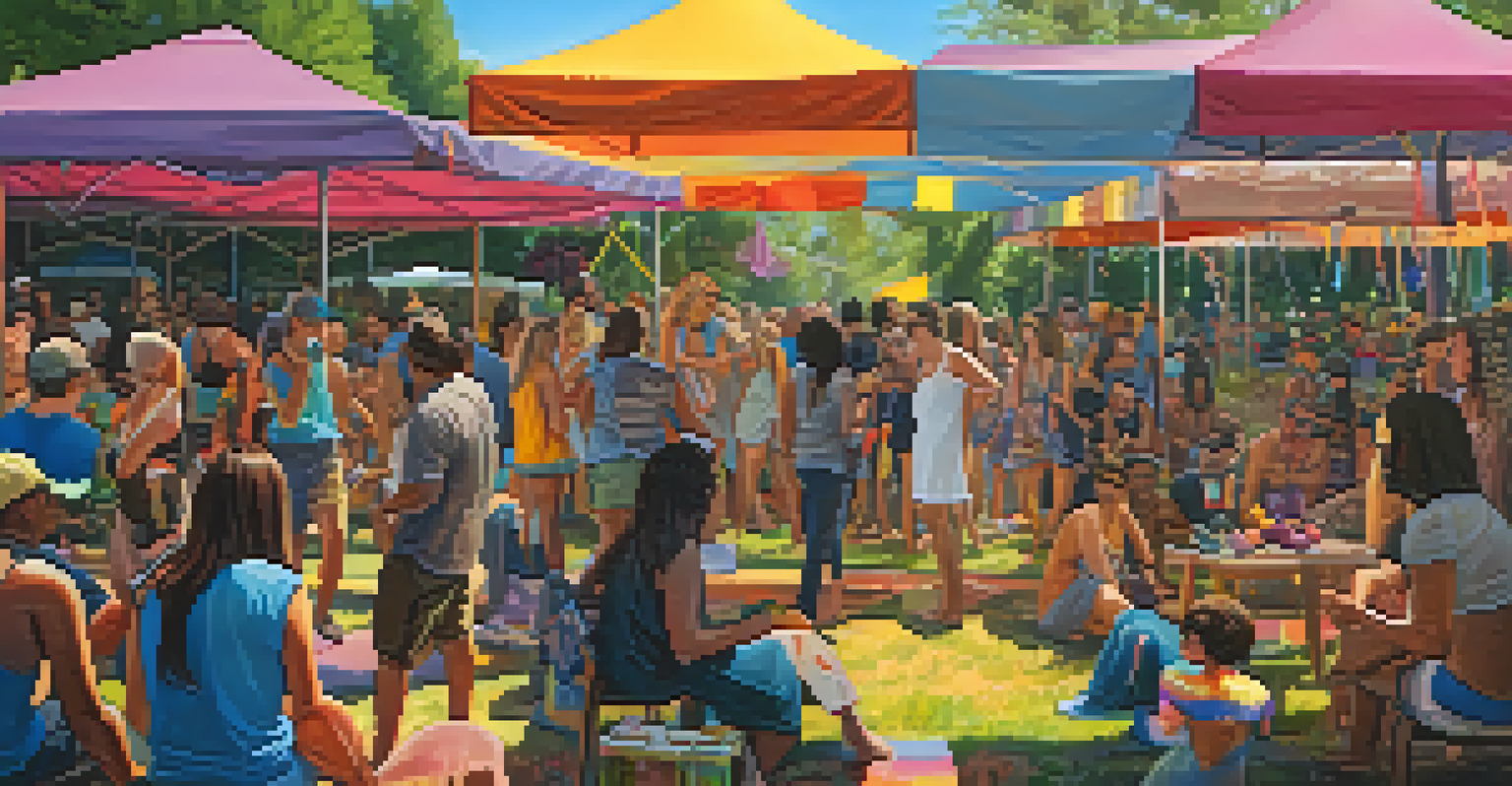Entheogens and Their Symbolism in Contemporary Artistic Expression

Understanding Entheogens: A Brief Overview
Entheogens are substances that people use to facilitate spiritual experiences or altered states of consciousness. Often derived from natural sources like plants and fungi, these substances have been used for centuries in various cultures for religious and healing purposes. The term 'entheogen' itself means 'generating the divine within,' highlighting their role in facilitating profound connections to the self and the universe.
Psychedelics are a tool that can help us see through the layers of illusion and connect with the deeper aspects of our existence.
In contemporary society, interest in entheogens has surged, particularly as people seek alternative paths to understanding consciousness and spirituality. This resurgence is not just limited to personal exploration; artists are increasingly drawing inspiration from these experiences to express complex emotions and ideas. As a result, the intersection of entheogens and art is becoming a rich area of exploration.
By examining how entheogens influence artistic expression, we can uncover deeper meanings in the artwork and the symbolism that pervades contemporary culture. This journey into the mind can help demystify the powerful experiences associated with these substances, providing insight into their role in creativity and expression.
Historical Context of Entheogens in Art
Throughout history, various cultures have incorporated entheogens into their artistic practices. Indigenous peoples, for example, have long used peyote and ayahuasca in their rituals, often resulting in striking visual art that reflects their spiritual experiences. This intertwining of art and spirituality showcases how deeply entheogens are rooted in human culture.

Similarly, artists during the 1960s counterculture movement embraced psychedelics, leading to a flourishing of visual art that portrayed vibrant colors and surreal landscapes. These works often aimed to communicate the ineffable experiences induced by these substances, pushing the boundaries of conventional artistic expression. The artwork from this era remains iconic, influencing generations of artists and the broader cultural landscape.
Entheogens Enhance Artistic Expression
Artists are increasingly using entheogens to explore altered states of consciousness, leading to innovative and resonant artwork.
By understanding this historical context, we can appreciate how contemporary artists are standing on the shoulders of giants, using entheogens as a source of inspiration. This legacy of creativity continues to evolve, reflecting both the beauty and complexity of the human experience.
Entheogens as a Source of Inspiration for Artists
Many contemporary artists are openly discussing their experiences with entheogens and how these moments of insight fuel their creativity. For them, these substances can unlock new ways of seeing the world and understanding their own emotions. This fresh perspective often translates into artwork that resonates on multiple levels, inviting viewers to reevaluate their own perceptions.
The artist is the creator of beautiful things. To reveal art and conceal the artist is art's aim.
For instance, artists like Alex Grey create intricate pieces that incorporate the themes of interconnectedness and spirituality often associated with psychedelic experiences. His work transcends traditional boundaries, inviting viewers to explore their inner landscapes. Such art serves not only as a reflection of personal experiences but also as a communal exploration of consciousness.
This artistic exploration of entheogens encourages a broader dialogue about mental health, spirituality, and the nature of reality. As these conversations unfold, they help destigmatize the use of entheogens and promote a more nuanced understanding of their role in personal and collective healing.
Symbolism of Entheogens in Modern Art
Symbolism plays a crucial role in contemporary art, particularly when it comes to depicting the experiences associated with entheogens. Artists often use vibrant colors, intricate patterns, and surreal imagery to evoke the profound emotional and spiritual states induced by these substances. This symbolism can create a bridge between the artist's inner world and the viewer's interpretation.
For example, fractal patterns are commonly found in psychedelic art, representing the infinite complexity of the universe and the interconnectedness of all beings. These patterns can elicit feelings of awe and wonder, inviting viewers to explore their own experiences with consciousness. Such symbolism not only enhances the visual impact of the artwork but also fosters deeper connections between the audience and the creator.
Historical Roots of Entheogenic Art
The use of entheogens in artistic practices can be traced back through history, influencing various cultures and movements.
Moreover, the use of symbolism allows artists to communicate complex ideas that might be difficult to express through words alone. This visual language transcends cultural barriers, enabling a shared understanding of the human experience that is rich with emotion and meaning.
Contemporary Artists Influenced by Entheogens
Numerous contemporary artists draw inspiration from entheogenic experiences, each interpreting the influence in unique ways. One prominent figure is the artist Amanda Sage, whose work often features themes of transformation and consciousness. Through her vibrant and immersive pieces, Sage invites viewers to embark on their own journeys of self-discovery and introspection.
Another example is the renowned artist and musician, Brian Eno, who incorporates the concept of altered states into his sound art. His ambient music often evokes feelings similar to those experienced during entheogenic journeys, creating a space for contemplation and connection. This kind of work illustrates how entheogens can inspire not just visual art but also auditory experiences.
These artists, among many others, challenge conventional norms and encourage a broader acceptance of the transformative potential of entheogens in artistic expression. Their work serves as a reminder of the beauty that can emerge from exploring the depths of consciousness and the human experience.
The Role of Community in Entheogenic Art
Community plays a vital role in the exploration of entheogens and their impact on artistic expression. Many artists engage with like-minded individuals to share experiences and insights, fostering a supportive environment where creativity can flourish. This collaborative spirit often leads to the creation of art that embodies a collective consciousness.
Events such as art festivals and workshops centered around entheogens encourage artists to come together, share their perspectives, and inspire one another. These gatherings can be transformative, not only for the artists but also for the audience, as they witness the powerful synergy that emerges from shared experiences. The sense of belonging and connection can amplify the creative process.
Community Drives Creative Collaboration
Supportive artistic communities foster collective exploration of entheogens, enriching the creative process and deepening connections.
Furthermore, community-driven art initiatives often focus on themes of healing and wellness, utilizing entheogens as a tool for personal and collective growth. This approach emphasizes the importance of collaboration and collective exploration in the artistic process, ultimately enriching the artistic landscape.
Future Directions: Entheogens and Artistic Expression
As society becomes more open to discussing and exploring entheogens, we can expect to see their influence on artistic expression continue to grow. The ongoing research into the therapeutic benefits of these substances may encourage more artists to incorporate their experiences into their work, leading to innovative forms of expression. This evolution could redefine the boundaries of contemporary art.
Moreover, the intersection of technology and art presents exciting opportunities for exploring entheogenic themes. Virtual reality experiences and interactive installations can simulate altered states of consciousness, providing audiences with immersive experiences that echo the effects of entheogens. This fusion of technology and art could open new avenues for creative expression.

Ultimately, the future of entheogens in art holds the promise of deeper connections between individuals, communities, and the cosmos. As artists continue to delve into these transformative experiences, we can anticipate a vibrant tapestry of creative expression that reflects the complexities of human consciousness and the ongoing quest for understanding.